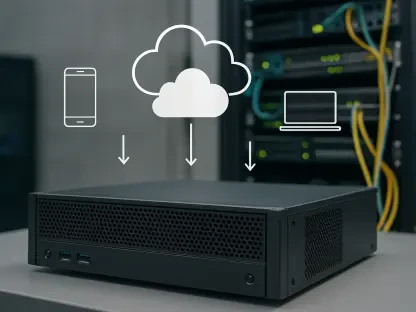In an era where digital connectivity underpins nearly every aspect of business and innovation, the complexity of managing modern networks has become a significant hurdle for organizations worldwide, prompting urgent solutions. Meter, a San Francisco-based startup specializing in Network-as-a-Service (NaaS), has stepped into the spotlight with groundbreaking announcements at their recent MeterUp conference on November 18. With the proliferation of devices, data-intensive applications, and the integration of artificial intelligence (AI), the demand for simplified yet robust networking solutions has never been more pressing. Compounding this challenge is a shrinking pool of skilled network engineers, leaving many companies struggling to maintain efficient operations. Meter is addressing these pain points head-on by pioneering a vision for fully autonomous networks, combining purpose-built hardware, a custom operating system, and cutting-edge AI tools to redefine how networks are designed and managed. This bold approach promises to alleviate the burden on IT teams and pave the way for seamless scalability in an increasingly connected world.
Revolutionizing Connectivity with New Hardware
Meter’s latest hardware lineup, unveiled at the conference, comprises nine innovative platforms that span wireless access, switching, security, and cellular connectivity. This comprehensive portfolio includes tri-band Wi-Fi 7 access points for high-performance wireless needs, multi-gigabit switches tailored to various deployment sizes, firewalls with automatic failover for enhanced reliability, and 5G gateways offering robust backup options with impressive throughput. What truly distinguishes these devices is the uniform firmware and operating system running across all of them. Unlike traditional multi-vendor environments where IT staff must navigate a maze of disparate systems and interfaces, Meter’s cohesive ecosystem ensures consistency in management and data collection. This standardization not only simplifies day-to-day operations but also sets a strong foundation for advanced automation, enabling organizations to focus on strategic goals rather than getting bogged down by technical intricacies of network hardware compatibility.
Beyond the technical specifications, Meter’s hardware design reflects a deep understanding of the practical challenges faced by modern enterprises. The emphasis on redundancy and reliability, as seen in features like automatic failover in firewalls and high-speed cellular backups in 5G gateways, addresses the critical need for uninterrupted connectivity in mission-critical environments. Additionally, by controlling both the hardware and software layers, Meter can optimize performance and security in ways that fragmented, multi-vendor setups often struggle to achieve. This vertically integrated approach reduces the likelihood of compatibility issues and streamlines troubleshooting processes, saving valuable time for IT teams already stretched thin. As network demands continue to escalate with the rise of remote work and cloud-based applications, such hardware innovations offer a glimpse into a future where connectivity is not just powerful but also effortlessly manageable for businesses of all sizes.
Transforming Operations with AI-Driven Automation
At the core of Meter’s vision for autonomous networking lies Command, a sophisticated AI tool designed to revolutionize how networks are managed and supported. This powerful system automates an array of critical tasks, from network design to troubleshooting, handling an astonishing 85% of support tickets without any human intervention. By analyzing real-time telemetry data from connected devices, Command identifies issues and proposes solutions swiftly, significantly reducing the dependency on skilled engineers—a resource becoming increasingly scarce in the industry. This high level of automation is a game-changer for organizations grappling with the dual pressures of complex network environments and limited expertise, allowing them to maintain operational efficiency without the constant need for manual oversight or extensive training programs for staff.
Further enhancing its impact, Command excels in streamlining the initial setup of networks by generating comprehensive configurations based on minimal customer input. Tasks that once consumed weeks—such as defining topology, assigning VLANs, setting IP addresses, and establishing security policies—can now be completed in mere hours. This rapid deployment capability not only accelerates time-to-value for businesses but also aligns with the broader industry trend toward self-managing, intelligent networks that adapt dynamically to changing conditions. By minimizing human involvement in routine operations, Meter’s AI-driven approach mitigates the risk of errors and frees up IT personnel to focus on innovation rather than repetitive maintenance. As network complexity continues to grow, tools like Command represent a vital step toward a future where technology itself shoulders the burden of management, ensuring scalability and resilience for enterprises navigating an ever-evolving digital landscape.
Streamlining Management with Cloud-Based Configuration
Meter’s adoption of a cloud-centric “desired state configuration” model marks a significant evolution in network management, building on the principles of software-defined networking. Rather than requiring engineers to manually adjust settings on individual devices—a process prone to errors and inefficiencies—this system allows the intended network state to be defined through a centralized dashboard. Once specified, the platform automatically configures all connected hardware to align with that state, eliminating the common problem of configuration drift where devices fall out of sync over time. This approach ensures consistency across the network, simplifies scaling efforts, and enables rapid deployment of new setups, making it an ideal solution for organizations looking to keep pace with fast-changing technological demands without expanding their IT headcount.
The benefits of this cloud-based model extend to the ease of integrating new hardware into existing networks. Upon startup, devices authenticate with the platform and download their specific roles, policies, and addressing schemes, reducing setup time to a matter of minutes. This plug-and-play functionality is particularly valuable for businesses with distributed operations or those undergoing rapid growth, as it minimizes downtime and operational disruptions during expansion. Moreover, by centralizing network intelligence in the cloud, Meter’s architecture provides a single source of truth that enhances visibility and control, allowing IT teams to monitor and adjust network performance from anywhere. In an industry where agility and reliability are paramount, this innovative configuration strategy positions Meter as a leader in delivering networking solutions that are not only efficient but also adaptable to the unique needs of each organization, setting a new standard for operational simplicity.
Forging Strategic Partnerships for Comprehensive Solutions
Recognizing the limitations of providing end-to-end networking solutions independently, Meter has entered into a strategic partnership with a major telecommunications provider to integrate WAN circuit provisioning into its platform. This collaboration offers significant advantages, including volume pricing on fiber circuits, real-time updates on installation timelines, and unified visibility of both WAN and LAN health metrics through a single management interface. Available via a leading cloud marketplace, this alliance enables enterprises to leverage existing cloud spend commitments, further enhancing the value proposition. Such partnerships reflect an industry-wide acknowledgment that comprehensive networking requires collaboration, ensuring customers benefit from seamless, integrated services without navigating multiple providers or disjointed systems.
This strategic move also underscores Meter’s commitment to addressing the full spectrum of networking needs while maintaining a user-friendly experience. By consolidating LAN hardware management and WAN connectivity under one umbrella, the partnership reduces operational friction for businesses, allowing them to focus on outcomes rather than logistics. Additionally, plans to incorporate other ISP partners in the future indicate a flexible, forward-thinking approach that prioritizes customer choice and scalability. As network demands evolve with increasing data consumption and distributed workforces, such alliances are crucial for delivering holistic solutions that bridge local and wide-area networking challenges. Meter’s proactive stance in forging these relationships highlights a pragmatic understanding of market dynamics, positioning the company to meet diverse enterprise requirements with efficiency and innovation in a competitive landscape.
Paving the Way for Future Networking Excellence
Reflecting on Meter’s recent strides, the announcements made at the conference on November 18 marked a pivotal moment for the NaaS sector. The introduction of nine cutting-edge hardware platforms, paired with a unified operating system, showcased a dedication to simplifying network management through consistency and performance. Meanwhile, the Command AI tool demonstrated remarkable potential in automating complex tasks, handling a vast majority of support issues independently, and slashing deployment times. The cloud-based configuration model further solidified Meter’s innovative edge by ensuring seamless alignment and scalability across networks.
Looking ahead, the path forward involves building on these advancements to tackle ongoing industry challenges like the talent shortage and escalating network complexity. Meter’s focus should remain on scaling its platform to handle greater bandwidth demands while refining autonomous capabilities to further reduce human intervention. Exploring additional partnerships could enhance service offerings, ensuring comprehensive solutions for diverse customer needs. As the digital landscape continues to transform, embracing such strategies will be essential for sustaining momentum and delivering networking excellence that empowers organizations to thrive in an interconnected world.









